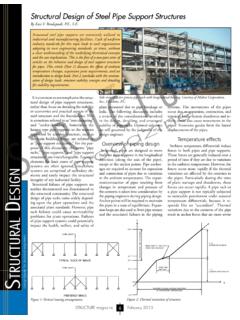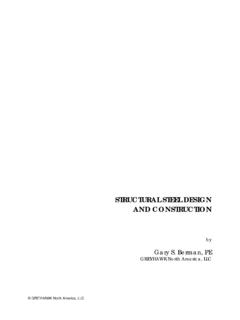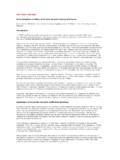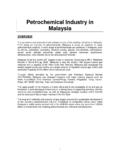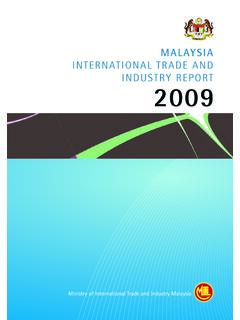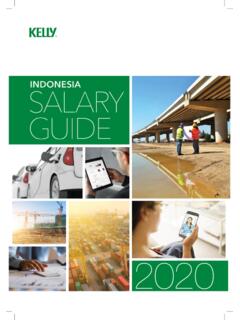Transcription of Design, Construction and Operation of the Floating Roof Tank
1 University of Southern Queensland Faculty of Engineering and Surveying Design, Construction and Operation of the Floating roof Tank A dissertation submitted by Submitted by Kuan, Siew Yeng in fulfilment of the requirement of Course ENG 4111 and ENG 4112 Research Project towards the degree of Bachelor of Engineering (Mechanical Engineering) Submitted: 29th October 2009 i ABSTRACT Storage tanks have been widely used in many industrial particularly in the oil refinery and petrochemical industry which are to store a multitude of different product with crude oil as one if it.
2 There are different types of tank such as fixed roof tank, open roof tank, Floating roof tank etc. Floating roof tank is which the roof floats directly on top of the product, with no vapour space and eliminating the possibility of flammable atmosphere. There are various industrial code and standard available for the basic requirement for tank design and Construction . Commercial software are also available in the market for the basic design, hence tank designer would rely wholly on the software without detail understanding.
3 Despite of the various standard and code, there is limited procedure and rules in designing the Floating roof which result lots of Floating roof failure and caused injuries and fatalities accident. Design and safety concern has been a great concern for the increasing case of fire and explosion due the tank failure. The main objective of this project is HOW TO DESIGN A NEW Floating roof TANK . The aim of this project is to develop basic rules and procedures, highlighting the concerns in designing, Construction and Operation of a Floating roof by taking an existing Oil Development Project with it s readily available information as a base, to design the tank, and identify the problematic and lesson learnt throughout the project.
4 Ii University of Southern Queensland Faculty of Engineering and Surveying ENG 4111 & ENG 4112 Research Project Limitations of Use The Council of the University of Southern Queensland, its Faculty of Engineering and Surveying, and the staff of the University of Southern Queensland, do not accept any responsibility for the truth, accuracy or completeness of material contained within or associated with this dissertation. Person using all or any part of this material do so at their own risk, and not at the risk of the Council of the University of Southern Queensland, its Faculty of Engineering and Surveying or the staff of the University of Southern Queensland.
5 This dissertation reports an education exercise and has no purpose or validity beyond this exercise. The sole purpose of the course pair entitled Research Project is to contribute to the overall education within the student s chosen degree program. This document, the associate hardware, software, drawings, and other material set out in the associated appendices should not be used for any other purpose: if they are so used, it is entirely at the risk of the user. Prof Frank Bullen Dean Faculty of Engineering and Surveying iii Certification I certify that the ideas, designs and experimental work, results, analyses and conclusions set out in this dissertation are entirely my own effort, except where otherwise indicated and acknowledged.
6 I further certify that the work is original and has not been previously submitted for assessment in any other course or institution, except where specifically stated. KUAN SIEW YENG 0050012450 _____ Signature _____ Date iv Acknowledgment This research was carried out under the principal supervision of Dr. Harry Ku and the co-supervisor is Dr. Talal. I would like express my great appreciation toward them for their kind valuable assistance and advice through out the project. Beside that, I would like to thanks the library of Technip malaysia which had provided me a lot of handful information and reference book as this project requires lot of reference and international code.
7 V TABLE OF CONTENT CONTENTS PAGE ABSTRACT i ACKNOWLEDGMENT iv LIST OF FIGURES xi LIST OF TABLES xvi CHAPTER 1: INTRODUCTION Rationale 1 Research Goal 2 Project Aims 2 Project Objective 2 Research Methodology Literature Review 3 Case Study 3 Product Enquiries 3 Design Approach 3 Consequential Effect of the Design Failure 4 Special Design and Construction 4 CHAPTER 2: LITERATURE REVIEW Introduction 5 Type of Storage Tank 7 Open Top Tank 7 Fixed roof Tanks 8 Floating roof Tanks 9 vi Design Code and Standard 10 Floating roof Tank 11 History and Introduction 11 Principles of the Floating roof 11 Advantages of the Floating roof Storage Tank 13 Design Data overview 13 Process Description and Requirements 15 Process Description and Design Consideration 16 Material Selection and Corrosion Assessment 19 CO2
8 Corrosion 19 Carbon Dioxide Corrosion Modeling 21 Mechanical Selection of Carbon Steel Grade 22 Mechanical Design 25 Tank Shell Design Method as Per API 650 26 Calculation of thickness by 1-Foot Method 26 Calculation of thickness by Variable-Design- Point Method 27 Calculation of thickness by Elastic Analysis 28 Mechanical Design consideration 28 Bottom Plate Design 30 Vertical Bending of Shell 30 Floating roof design 31 Special Consideration 32 Soil Settlement 32 Seismic Design for Floating roof 33 Failure Mode Due to Seismic Effects on Floating roof Tank 34 Fitting Design and Requirement 36 Typical Fitting and Accessories for Floating roof 37 vii roof Seal System 37 Support Leg 38 roof Drain System 39 Vent Bleeder vents 43 Centering and Anti-Rotation Device 44 Rolling Ladder and Gauger Platform 44 Fire Fighting System and Foam Dam 44 CHAPTER 3.
9 TANK DESIGN Introduction 46 Shell Design 46 Longitudinal Stress 47 Circumferential Stress 48 Longitudinal Stress versus Circumferential Stress 49 Circumferential Stress Thickness Equation and 1-Foot Method 49 Shell Design Thickness calculation 50 Top Stiffener and Intermediate Wind Girder Design Top Stiffener/ Top Wind Girder 51 Intermediate Wind Girder 54 Overturning Stability against Wind Load 57 Seismic Design 60 Site Geometry Design Data for Seismic Design 62 Overturning Stability 62 Design Spectral Accelerations 64 viii Parameter required for Seismic Design 65 Effective Weight of Product 69 Center of Action for effective Lateral Force 71 Ring Wall Moment 72 Base Shear Force 72 Resistance to Overturning 74 Anchorage Design 77 Freeboard 78 Seismic design Summary 79 roof Design 80 roof type Selection 80 Pontoon and Center deck Design 81 roof Stress Design 82 Effect of large Deflection on Center Deck 83 Pontoon
10 Stability Pontoon Ring Design 86 Fitting and Accessories Design 89 roof Seal System 90 roof Seal Material 95 roof Support Leg 96 Venting System 98 Operation of Bleeder Vent 98 Bleeder Vent Design 101 roof Drain System 104 Articulated Piping System 105 Flexible Drain Pipe System 107 ix Drain System Selection 109 Drain Pipe Design 110 Rolling Ladder & Gauger Platform 112 Fire Fighting System and Foam Dam 113 CHAPTER 4: TANK Construction Introduction 116 Foundation 117 Bottom Plate Placement 118 Shell Erection 121 Tank Testing Tank Bottom Testing 123 Tank Shell Testing 123 Floating roof Testing 125 CHAPTER 5: SPECIAL Construction Design consideration Design Consideration of Foundation 127 Design consideration on Tank Shell 129 Construction Consider
